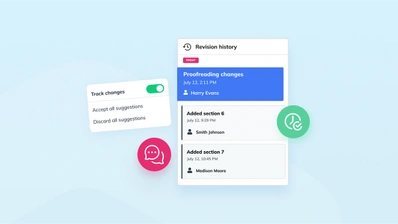5 best collaborative writing strategies for 2022

The art of good writing requires not only a fair amount of talent and a great deal of inspiration, but also some down-to-earth factors such as providing enough time, space, and comfort. The right strategy and the perfectly-organized collaboration process tend to be also in the mix. And because collaborative writing is getting increasingly popular within modern organizations these days, more and more employees, even during individual writing, write and revise texts on behalf of a team of collaborators.
It’s not true that great content can only be created by the extraordinarily-talented lone wolves who have it all. The truth is that nobody has it all, and no one can be perfect at writing compelling stories, checking facts and figures, and spotting every flaw. To make content immaculate or at least close to perfection, a great team is required. And it needs to follow a well-thought-out and precisely-selected collaborative writing strategy.
Also, it’s not true that the only means for collaborative writing is brainstorming, with separate notes taken by different group members, who need to meet at least several times to move on with the workload. This obsolete way of creating content - with countless meetings involved - is regarded by many employees as a difficult, unpleasant, and frustrating experience, to say the least. Luckily, there are solutions that can make it more rewarding and productive, such as using tools like CKEditor 5. It can help contributors speed up progress, and not get stuck in the weeds for ages.
Group writing mindset in a nutshell
If you’re wondering what writing collaboratively, or the collaborative writing process, actually is, it may be described as “the process of producing a written work as a group where all team members contributed to the content and the decisions about how the group will function”.
It’s enough for a group to consist of more than one writer to call their content production “collaborative writing", as opposed to individual work. Sometimes, though, it’s just peer reviewing, and not team writing per se, that is referred to as collaborative writing.
Some of the benefits of getting together to collaborate on a writing assignment include:
- mastering writing patterns by observing what colleagues are doing
- learning conventions for particular types of written content
- compiling and coordinating content quickly
- perfecting the art of deconstructing texts, perceptiveness, and an eye for detail
- making content more creative but also accurate, as more people are involved in the process and feel responsible for the outcome
- getting a sense of audience and learning how to satisfy readers’ expectations
What’s more, modern collaborative writing is regarded as one of the main elements of the business environment and something many organizations depend on.
The best collaborative writing strategies to follow in 2022
But what, in detail, are the top strategies for writing collaborative content? And, which ones of them may be called collaborative strategies that work and are worth following in 2022?
Writing collaboratively, indeed
The general rule of team collaboration should shape the mindsets of all content creators involved in the writing assignment from day one. The first advantage of this approach is that the content created doesn’t adopt one person’s voice or multiple voices in consecutive parts. To achieve this, the primary “drafters” can start the writing process, followed by other group members, who take the positions of reviewers and editors, contributing with their views and ideas.
It’s best when those several activities or tasks that a writing assignment is broken down into get rotated between the contributors. Such a strategy makes everyone involved in the process, but not overburdened too much. This approach also allows for the content to stay coherent, so that no ruptures or discrepancies between certain parts are visible. That’s great because the worst thing we can do is simply assign specific parts to be written by particular contributors, some authors argue.
Being well-prepared
Planning ahead of time, smart coordination and leadership as well as an equal division of labor, and equal sharing of responsibilities, are crucial as far as good strategies for collaborative writing are concerned. This should cover both the editing and reviewing phases, and embrace such elements as criteria for success and content outline. Other important prerequisites are everyone’s dependability, thoughtfulness, and courtesy when communicating with other group members.
But today, busy schedules are no longer an obstacle to making collaborative writing projects smooth and efficient. Real-time collaboration tools, such as CKEditor 5, let people make use of every moment available to produce high-quality content, co-author various assignments, and simply write together. They can leave comments and suggestions at any time, regardless of whether other collaborators in the group work on the document at the same time, or not. Useful features, such as Revision History or Track changes, make the whole writing process clearer and easier to handle, e.g. by giving opportunities to come back to previous versions of the text, and figure out who wrote what and when.
Trading places within the writing assignment
To keep team members engaged and make them feel responsible for the collaborative writing project some authors suggest that every group member should take on at least two of the relevant roles within the content-creation process. These roles may include writers, editors, group leaders, graphic designers, etc., and they may overlap when necessary. This flexibility can be treated as a general rule for the right approach to the issue of the strategies collaborative writing involves.
Juggling with options and strategies
Writing strategies are not set in stone for any particular team and it’s definitely worth being flexible in this regard. This is especially true since, within modern organizations, a single team of contributors is hardly ever involved in multiple group projects. For this reason, it’s good to be open to different solutions for different assignments and use cases.
The strategies to choose from include:
- One-for-all writing - sole authorship of a single author writing on behalf of the whole team
- Each-in-sequence writing - passing the writing assignment from one author to another; perfect for groups that work asynchronously
- All-in-parallel writing - when multiple authors work simultaneously on separate, independent sections of the writing task
- All-in-reaction writing - a real-time collaboration of authors who adjust to each other’s contributions; perfect for small groups that are non-hierarchical ones
- Multi-mode writing - a combination of the above-mentioned strategies for collaborative writing when separate methods are used for various phases of the very same project
Involving cutting-edge technology within the writing process
Too many real-life meetings can spoil the broth instead of making it thicker, as well as sending drafts and corrections back and forth over email. These days, utilizing modern tools and devices is what makes the workflow smoother and more efficient, also when it comes to collaborative editing. It lets content creators of all kinds take the burden off their shoulders. They don’t have to be afraid of participating in another tiring real-life brainstorming session anymore. And the right real-time collaboration tool can provide support and assistance from day one until the very end of the project.
Collaborative writing process: how CKEditor 5 can help
Collaborative writing processes can be upgraded greatly and easily with the help of the right real-time collaboration solution or tool. Some scholars even advise and recommend using word-processing software that allows for online collaboration. And this is the case of CKEditor 5 as it enables teams to complete all their content creation tasks smoothly, making the whole collaborative process highly efficient on one hand and pleasant on the other.
No large or frequent - soul-sucking or time-wasting - real-life gatherings are necessary anymore. Team members may cooperate either at the same time or asynchronously - they can just drop in and collaborate sitting in front of their computers whenever they feel like doing it. Obviously, the modern teams that tend to be dispersed geographically, and even work and collaborate across different time zones, are great beneficiaries of this solution.
CKEditor 5 allows for the assignment, itself, to be performed not only faster but also better. This is thanks to the participation of many unique contributors who wouldn’t be able to leave their mark on the project if only on-site participation was possible. What they readily make use of are the renowned CKEditor 5 collaboration features such as Comments, Track Changes, and Real-time collaborative editing that can easily be tailored to particular business needs. What’s crucial is that these features can make content collaboration smooth, regardless of what phase it is in - writing, reviewing, proofreading, or feedback gathering.
There are many well-thought, specific CKEditor 5 solutions that not only support content collaboration but also help make the most of it, by increasing productivity. The latter include features such as media embed and responsive images, paste from Office (including pasting from Word and Google Docs), as well as autoformatting and keyboard support, to name but a few of the great options this tool comes with.
Organizations of various sizes and industries who switched to CKEditor 5 (and there are many powerful household names, top software corporations as well as creative start-ups among them) appreciate and praise it for its superb support, immaculate documentation, and being always ahead of its competitors in terms of providing new, head-turning features, and other useful amenities.
Oftentimes, they moved to CKEditor 5 from seemingly similar solutions, such as more obsolete editors lacking real-time collaboration, GDoc, and the like. CKEditor 5 is a go-to solution because it is a complex editing framework - you have all you need right within your single application without the need to use editors like Google Docs, Microsoft Word, or other third-party applications.
Why is CKEditor so unique? “No other rich-text editor provided the same editing capabilities, performance, ease of integration, and customizations”, emphasizes Dennis Gurrock, Co-Founder of Testmo.
If you, too, want to see for yourself how powerful CKEditor 5 is, and how greatly it can enhance your content creation or writing strategy, don’t hesitate to try our real-time collaboration demo or contact us now!
You can read more on the topic of collaboration in our blog posts:
- CKEditor helps: Collaborative policy in government
- The keys for an optimal digital employee experience
- Collaboration journey of CKEditor 5 - What were we up to
- Bringing collaborative editing to any application
- Data compression in real-time collaboration
- 7 reasons why your LMS needs a better and collaborative WYSIWYG editor
- Lessons learned from creating a rich-text editor with real-time collaboration


